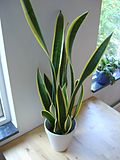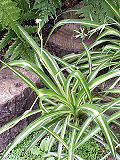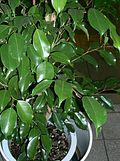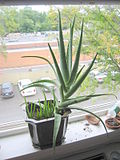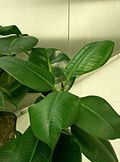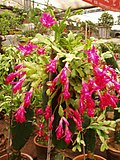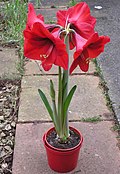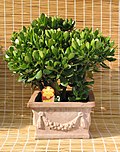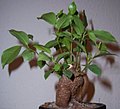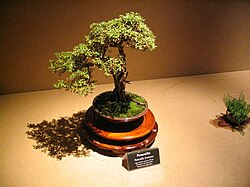AY Honors/House Plants/Answer Key
1. Name at least five house plants raised for their foliage.
2. Name three house plants raised for their flowers.
3. Name three house plants adapted to direct sunlight, dry soils, and very moist soils.
House plants adapted to direct sunlight
- 567px-Alpenveilchen Cyclamen 1.jpg
Cyclamen persicum (Cyclamen)
House plants adapted to dry soils
House plants adapted to very moist soils
4.Most house plants like a 65-to 75-degree (18 C - 22 C) temperature. Name one that requires a cool room (45 to 55 degrees F.) (7 C - 13 C).
The cyclamen commonly sold by florists is C. persicum, which is frost-tender. Selected cyclamen cultivars can have white, bright pink, red or purple flowers. While flowering, florists' cyclamens should be kept below 68 °F (20 °C), with the night time temperatures preferably between 44 °F to 59 °F (6.67 °C to 15 °C). Temperatures above 68 °F (20 °C) may induce the plant to go dormant.
5.Prepare a special potting mix soil including at least 3 different ingredients. Select two house plants from requirement two and grow them in this soil for three weeks.
Template:Adventist Youth Honors Answer Book/Problematic requirement
There are potting soil recipes all over the web, including these:
A search engine such as Google or Yahoo will surely turn up more.
Soil Ingredients
Different potting soil ingredients impart different properties to the soil. We list several ingredients here along with their characteristics:
- Clay
- Clay is soil that sticks together into a ball when compressed. It is impermeable to water, so it inhibits drainage. It is very common in garden soil and is typically avoided as a potting soil ingredient.
- Silt
- Silt is soil or rock derived granular material of a specific grain size. Silt may occur as a soil or alternatively as suspended sediment in a water column of any surface water body. It may also exist as deposition soil at the bottom of a water body.
- Sand
- Sand is made up of mineral grains larger than those that make up silt. Water will pass through sand, so it is useful in creating well-drained soils.
- Perlite
- Perlite is an amorphous volcanic glass that has a relatively high water content. It makes composts more open to air, while still having good water-retention properties. It can therefore hold water in the soil until it is needed by a plant.
- Vermiculite
- Vermiculite is a natural mineral that expands with the application of heat. It is very similar to perlite and has many of the same properties.
- Peat
- Peat is soft and easily compressed. Under pressure, water in the peat is forced out. It is also dug into soil to increase the soil's capacity to retain moisture and add nutrients.
- Humus
- Humus refers to any organic matter which has reached a point of stability, where it will break down no further and might, if conditions do not change, remain essentially as it is for centuries, if not millennia. It is often the basis for potting soils.
- Compost
- Also known as brown manure, compost is the aerobically decomposed remnants of organic matter. Compost serves as a growing medium,or a porous, absorbent material that holds moisture and soluble minerals, providing the support and nutrients in which most plants will flourish. To maximize plant growth, it is sometimes necessary to dilute compost with soil or peat to reduce salinity or to add neutralisers to bring the pH closer to 7, or additional nutrients like fertilisers or manure, wetting agents, and materials to improve drainage and aeration, such as sand, grit, bark chips, vermiculite, perlite, or clay granules.
- Manure
- Manure is organic matter used as fertilizer. Manures contribute to the fertility of the soil by adding organic matter and nutrients, such as nitrogen that is trapped by bacteria in the soil. Manure is generally acidic, lowering the soil's pH. It is often combined with lime to bring the pH back to a neutral level.
- Pea gravel/crushed stone
- These are often layered at the bottom of a pot to promote drainage. Crushed stone will also raise the pH of the soil making is less acidic.
- Fertilizer
- Inorganic fertilizers are described by three numbers (such as 10-20-20) which specify the amount of Nitrogen (N), Phosphorus (P) and Potassium (K) they contain. These are essential plant nutrients.
- Lime
- Lime is used for raising the pH of soil. Combined with manure, the horticulturalist can set the soil's pH level to a plant's optimum level.
- Bonemeal
- Bone meal is a mixture of crushed and coarsely ground bones that is used as an organic fertilizer. As a slow-release fertilizer, bone meal is primarily used as a source of phosphorus.
- Blood meal
- Blood meal is dried, powdered animal blood used as a high-nitrogen fertilizer. It is one of the highest non-synthetic sources of nitrogen and if over-applied it can burn plants with excessive ammonia. Blood meal is completely soluble and can be mixed with water to be used as a liquid fertilizer.
- Pine bark
- Shredded bark will make soil hold more water.
Plant Needs
| Plant | pH range | Soil range | Water range | Notes |
|---|---|---|---|---|
| Narcissus | 4.5-8.5 | Sandy Loam to Clay Loam | Well-drained | Do not include organic amendments. |
| Aspidistra | 5.5-7.5 | Mostly Sand to Mostly Clay | Normal to moist | |
| Philodendron | 5.5-6.5 | Sandy Loam to Clay Loam | Normal to moist | |
| Aluminum plant | 5.5-6.5 | Loam | Normal to moist | |
| Daffodil | Daffodils are the same thing as Narcissus. | |||
| Sanseveria | 5-7 | Sandy loam to Clay loam | Normal to moist | Snake plant |
| Boston fern | 5-6.5 | Some sand to Loam | Normal to wet | |
| Piggy-back plant | 4.5-7.5 | Sandy loam to some clay | Normal to moist | |
| Bird's nest fern | 5.5-6.5 | Loam to Clay | Moist | |
| Caladium | 4.5-6.5 | Sandy loam to Clay loam | Normal to moist | |
| Gloxinia | 7-8.5 | Sandy loam to loam | Moist | High pH (use lime and avoid manure) |
| Spider plant | ||||
| Geranium | ||||
| Maidenhair fern | ||||
| Begonia | ||||
| Ficus | ||||
| Tulip | ||||
| Iris | ||||
| Crocus | ||||
| Coleus | ||||
| Hyacinth |
6.How much light does an African violet need? Where in the house is the best place to grow them? Grow two or more African violets.
African Violets do best when the available light is about 1000 foot candles, though unless you have access ot a light meter, this information is not terribly useful. Instead, you should learn how to tell if the plant is getting too much or too little light by observing its leaves. If they receive too much light, the leaves will turn pale or yellowish green. If they are not receiving enough, the leaves will turn a deep, dark shade of green. African Violets need fairly bright light, but should not be placed in direct sunlight. Rather, they need diffuse, indirect light. If you place your hand between the plant and its light source, your hand should cast a shadow, but it should not feel too hot. This light level can typically be attained by placing the plant about one meter from a southeast- or west-facing window.
Furthermore, they will not bloom unless they have at least eight hours darkness every day, so if you are growing them under lights, make sure the lights are on a timer.
7.All gesneriads need approximately the same growing conditions. Where do they come from originally? What kind of temperature, light, and humidity do they need?
Saintpaulia, commonly known as African violet, is a genus of 6 species of herbaceous perennial flowering plants in the family Gesneriaceae, native to Tanzania and adjacent southeastern Kenya in eastern tropical Africa, with a concentration of species in the Nguru mountains of Tanzania.
African violets prefer a constant temperature between 20-25 °C (68-77 °F) with high humidity, and thrive best planted in well-drained humus or coir compost.
8. Name two house plants that can be propagated from leaves, stem sections or divisions. Select one plant from requirement two above, experiment with each of these methods of propagation and keep them growing for three months.
Template:Adventist Youth Honors Answer Book/Problematic requirement
- a. Narcissus
- b. Aspidistra
- c. Philodendron
- d. Aluminum plant
- e. Daffodil
- f. Sanseveria
- g. Boston fern
- h. Piggy-back plant
- i. Bird's nest fern
- j. Caladium
- k. Gloxinia
- l. Spider plant
- m. Geranium
- n. Maidenhair fern
- o. Begonia
- p. Ficus
- q. Tulip
- r. Iris
- s. Crocus
- t. Coleus
- u. Hyacinth
9. What is a Bonsai?
Bonsai is the art of aesthetic miniaturization of trees by growing them in containers. Cultivation includes techniques for shaping, watering, and repotting in various styles of containers. The word bonsai has been used in the West as an umbrella term for all miniature trees.
10. What is humidity? How is it important to house plants?
Humidity is the amount of water vapor in the air. The term "humidity" is usually taken in daily language to refer to relative humidity. Relative humidity is defined as the amount of water vapor in a sample of air compared to the maximum amount of water vapor the air can hold at any specific temperature in a form of 0 to 100%.
Humidity, along with temperature, moisture, light, soil mixture, fertilizers, potting, and pest control, is one of the critical factors that should be considered when caring for a houseplant.
Humidity is slightly more difficult to control than temperature. The more commonly used houseplants have established that they can survive in low humidity environments as long as their roots are kept properly irrigated. Most plants thrive in 80% relative humidity while most homes are usually kept around 20% to 60% relative humidity. Besides buying a humidifier, there are a few things that can be done to increase humidity around houseplants. The most popular methods used to raise the ambient humidity are misting and pebble trays, which are shallow trays covered with pebbles and filled with water that evaporates to increase humidity. Other methods of raising humidity include grouping plants closely together and not placing plants in drafty areas. Misting is somewhat controversial among gardeners, with some that swear by it and others that say it does little to increase humidity around plants.
11. Below is a lists of plants to chose from for requirement five and eight above:
| a. Narcissus b. Aspidistra |
h. Piggy-back plant |
o. Begonia |
